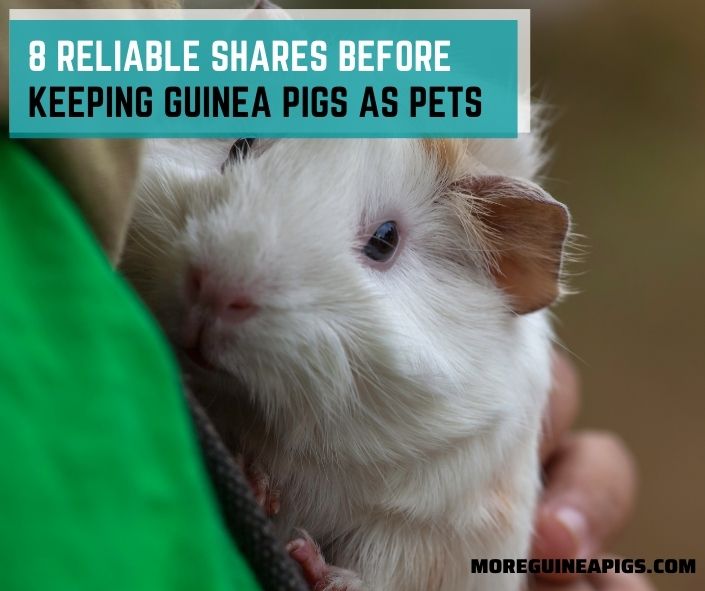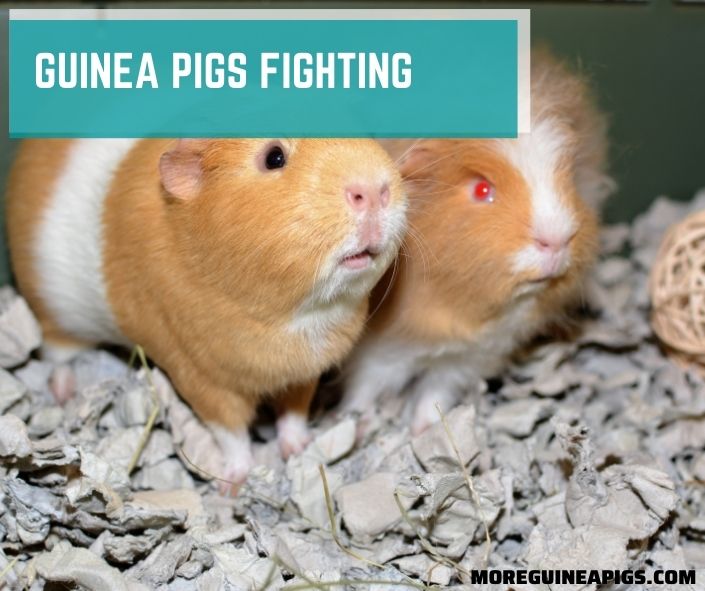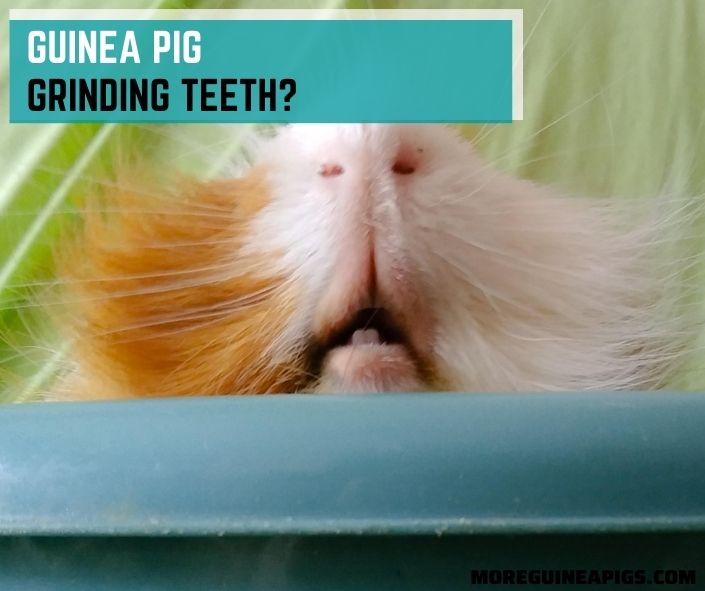8 Reliable Shares Before Keeping Guinea Pigs As Pets
Owning a pet is one of life’s most rewarding experiences, and guinea pigs are no exception. These small yet lovable creatures are smart, funny, personable, and come with their own unique personalities.
As a guinea pig owner, you can expect years of companionship with your furry friend and memory-making moments that you’ll always cherish.
If you’ve been considering adding a guinea pig to your family, it will be important to identify beforehand if this pet is suited to your lifestyle.
Cavies have unique needs and requirements if they are to live long and happy lives, and there will be much to learn before you welcome piggies into your home.
Read on to learn everything there is to know about being a guinea pig parent including how much they cost, how to keep them socialized, the best ways to handle them, what supplies you’ll need, and much more.
8 Reliable Shares Before Keeping Guinea Pigs As Pets
Guinea pigs make wonderful pets and are relatively easy to care for. Their small size is appealing to those interested in low-maintenance pets and their gentle nature makes them ideal companions for nearly all ages.
However, like all pets, they do have unique needs that will require special attention.
Guinea Pigs Aren’t Expensive and Always Available
The average guinea pig will cost anywhere between $10 to $40 and may be purchased from a breeder or pet store. It’s also possible to adopt a guinea pig from your local animal rescue, which is usually a more budget-friendly option.
Before purchasing a guinea pig, do your research and buy from a reputable breeder or source. This will ensure that you are getting a healthy guinea pig and supporting high-quality breeding facilities.
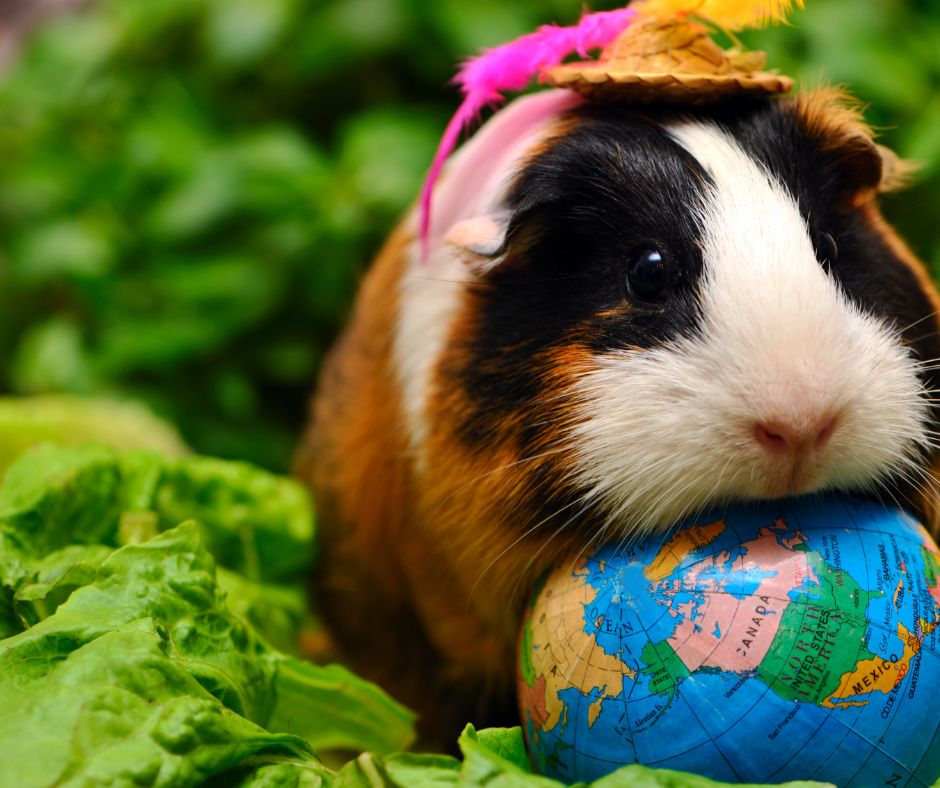
Guinea Pigs Are Social Animals
Cavies are social by nature and don’t like to live alone. If you’re going to adopt a guinea pig, be prepared to adopt at least two.
In the wild, cavies live in groups of at least ten, but same-gender duos will enjoy each other’s company just fine. If you keep a male and a female together, you may find yourself with unwanted litter.
Guinea pigs are best kept in pairs, but there are many piggie parents that have success with multiple guinea pigs. Females are able to happily live together, and most of the time, two males will get along as long as there isn’t a female nearby.
There is no right or wrong answer as to how many guinea pigs you can have together as long as you don’t have a loner and any males living with a female are castrated.
Some guinea pig owners have tried to house their cavies with rabbits, but this is not recommended and should be avoided.
Rabbits tend to bully guinea pigs if kept in the same habitat. They’re also carriers of Bordetella bronchiseptica, a bacteria that is the most common cause of respiratory problems in cavies.
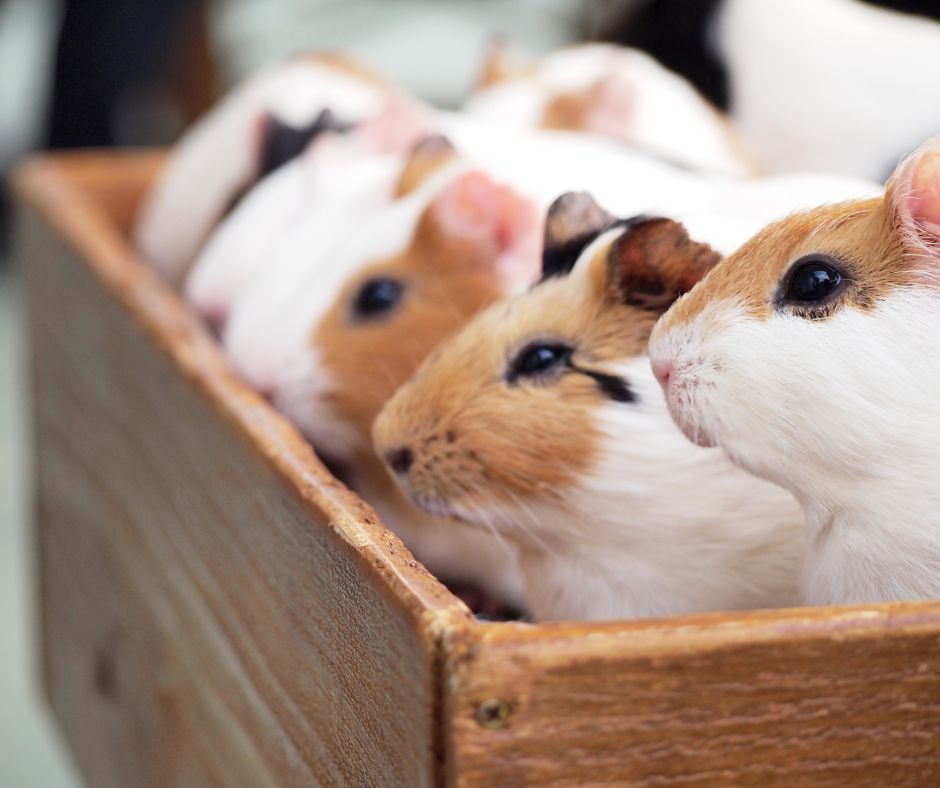
Guinea Pigs Are Vocal Animals
Contrary to popular belief, guinea pigs are quite vocal creatures and often use noises to communicate and express themselves.
Here are just some of the most common sounds a cavy will make and what they mean:
- Squealing: If your cavy friend lets out a high-pitched squeal or whistle, it means they’re excited. You may hear this the most during playtime or mealtime.
- Hissing: Much like a cat, a guinea pig will hiss if it’s feeling angry or aggressive. Hissing may also be accompanied by teeth chattering.
- Purring: This form of communication is also very similar to cats and usually means your cavy is content. However, depending on the pitch, it can also indicate that it is feeling annoyed or afraid. If your furry friend is scared, high-pitched squeals may follow the purring.
- Chirping: When in a trance-like state, your guinea pig will let out chirping noises. Experts have not been able to identify why this happens, but it’s mostly seen in piggies that have recently lost a partner.
Although guinea pigs aren’t overly noisy animals, they do have days in which they’ll be more rambunctious than others. If you’re seeking a quiet pet that you’ll never hear, it may be best to look elsewhere.
However, if you’re alright with the occasional squeaks during the night and the sound of them scurrying about in their cage, you’ll find that owning a communicative piggie can be a very fun and rewarding experience.
Guinea Pigs Are Active Animals
One of the most interesting things about a guinea pig is its activity habits. While they enjoy resting for long periods, they can also break into bouts of running around energetically, especially when they’re young.
It’s important that you allot 3-4 hours each day for your guinea pigs to play and stretch their legs outside of the cage. If they’re kept in their habitat all day, they’ll likely become frustrated and depressed.
When you let them out, keep them in a playpen or guinea pig-proofed room with toys to play with. They love hay or grass chew balls, stuffed socks, and obstacle courses.
Even something as simple as a crumpled-up piece of paper or a cardboard box can provide hours of entertainment for a guinea pig.
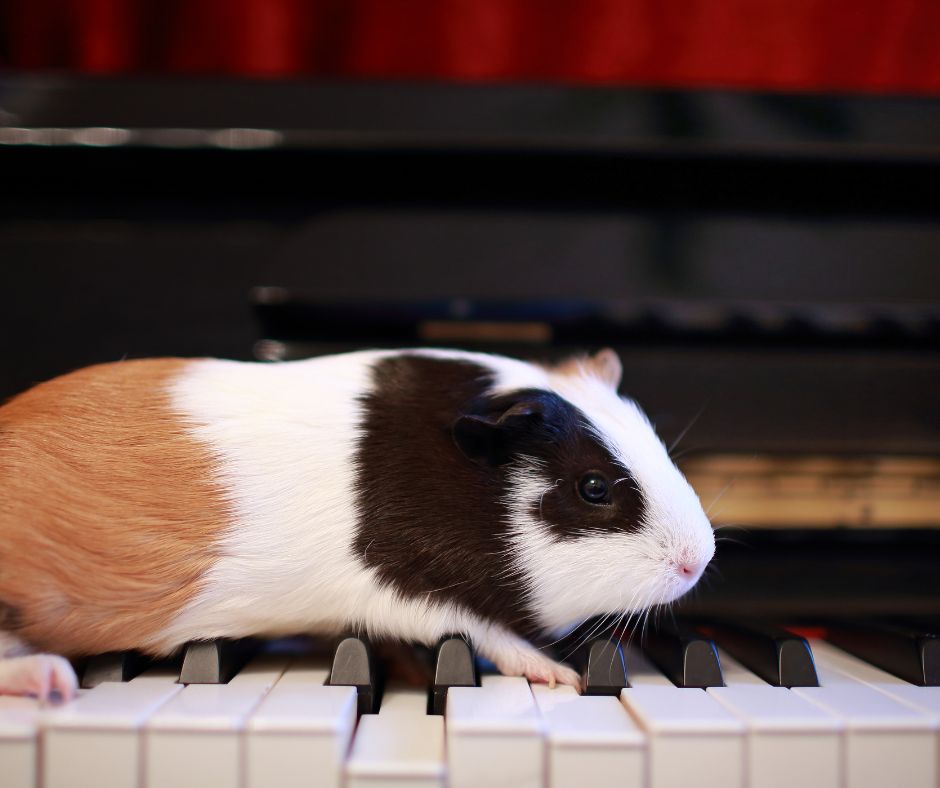
Guinea Pigs Need A Lot of Floor Space and Large Cage
As one of the largest rodents, guinea pigs require roomier housing than their smaller cousins like gerbils and hamsters. More space means your pet will enjoy more exercise and stimulation, leading to a healthier, happier, and longer life.
On average, one guinea pig needs a minimum of 7.5 square feet of space, but more is always recommended. If you have more than one piggie, the requirements are as follows:
- Two Guinea Pigs – 10.5 square feet
- Three Guinea Pigs – 13 square feet
- Four Guinea Pigs – 16 square feet
While shopping for your guinea pig’s home, keep in mind that corrugated plastic enclosures are endorsed by most cavy experts. A piggie should never be housed in a plastic tub, glass aquarium, or cage with a wire floor.
The ceiling of your guinea pig’s enclosure should also be at least 12 inches high. Some cavy owners will leave the top open for them as long as they can’t get out and other animals can’t get in.
Guinea pigs may be housed either indoors or outdoors as long as the temperatures are suitable.
They can easily survive outdoor temperatures between 64°F and 73°F, but if you live in an area where the temperature falls below 59°F or rises above 79°F, you’ll need to take extra measures to ensure they stay comfortable and won’t overheat during the summer or freeze in the winter.
If you plan to keep your piggies outside, you’ll need to place their hutch in a spot that is away from direct sunlight and protected from wind and rain.
Guinea Habitat Guinea Pig Cage by Midwest
If cold weather is in the forecast, you may want to consider moving the hutch indoors like in a shed or garage.
Otherwise, throwing a thick blanket over the hutch at night or during severe weather conditions will help keep them warm.
If you have more than one guinea pig, they’ll also be able to keep each other warm with their body heat. This is why it’s a good idea to have more than one, especially if they’re to be housed outdoors.
Cavies are also prey animals and are easily targeted by predators like cats and foxes when outside. To keep your precious piggies from becoming a meal, make sure their hutch is predator-proofed with extra padlocks, sturdy wood flooring, and strong bolts.
Remember, if a child can figure out how to open your guinea pig’s cage without your help, a fox can do the same.
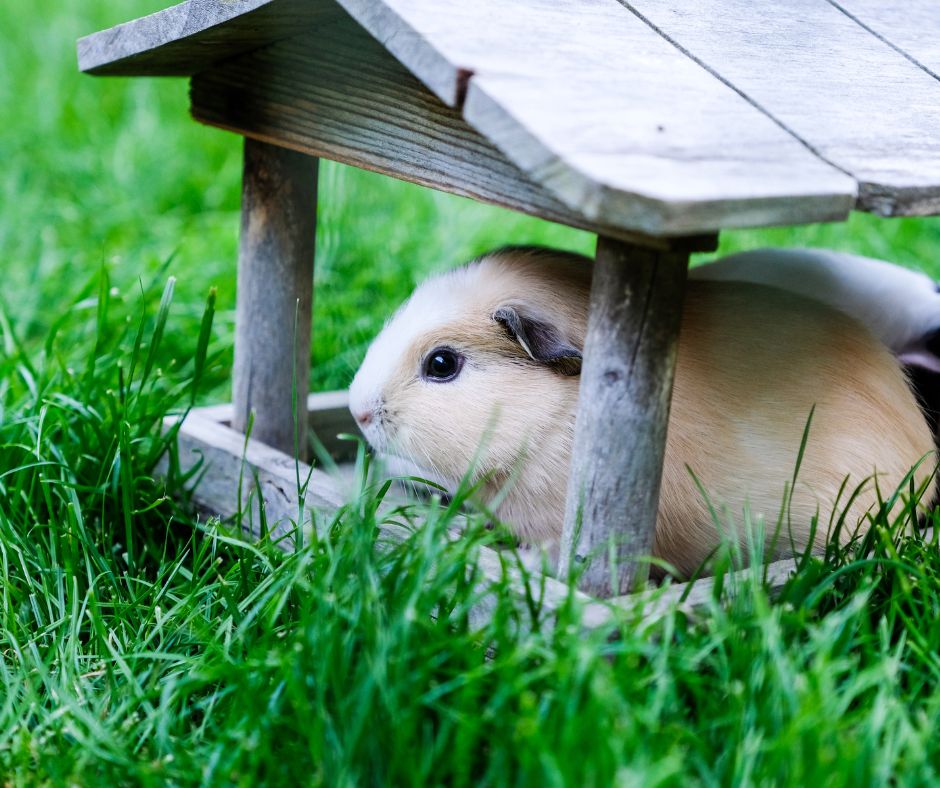
Guinea Pigs Are Easy To Tame and Handle
Despite their small size, guinea pigs are very intelligent animals and can be taught anything from a simple trick to how to use a litter box.
They can even distinguish your voice from others, recognize their name, and learn to understand certain hand gestures.
Since cavies are such social animals, they love to interact with their humans, including being held. However, their trust should be earned before you handle them regularly.
If you adopt a guinea pig, take the time to gradually build a relationship with your piggie so they’ll feel comfortable and safe in your arms.
To show your new piggie that you can be trusted, it’s best to avoid handling them the first few days. This will help them adjust to their surroundings and make them feel more comfortable.
During this time, you can talk to them through the cage so they become familiar with your voice and scent. They’ll also begin to associate your presence with food, helping them see you as something positive instead of scary.
When you feel your piggies have become accustomed to you, take them out of the cage and let them walk around on the floor. Make sure the room is secure and no other animals are present.
Sit on the ground and allow your guinea pig to come to you. You can begin picking it up by gently sliding your hand underneath its belly and letting them hang over your hand.
Bring their body close to your chest to help them feel safe. If they’re comfortable, use your free hand to gently pet them.
Be sure to remain seated the first few times you hold them. Over time, as you develop more trust and a deeper bond with your guinea pig, you’ll be able to stand up and walk around without distressing it.
Once you forge a bond with your guinea pig, you’ll find that these tiny animals can take up a large amount of real estate in your heart.
They are sweet and affectionate towards the humans they bond with, and at times will even squeal with delight when you come home from work.
Their fun and unique personalities will shine through as you get to know them, making them quirky and entertaining companions that you’ll be able to cherish for years to come.
Hanging Pet Cage Bowl Food
It is A Long-Term Commitment
Although guinea pigs are easy to care for, you must be prepared to share your home with them for quite some time. Unlike many of their rodent relatives, piggies can live for years on end.
The average lifespan of a guinea pig is 4 to 8 years, and this can be even longer if it’s well taken care of throughout its life.
To properly care for your guinea pig, you’ll need more than just food and toys. Some of the must-have items to keep your new piggie healthy and happy include:
VCZONE 15Pcs Guinea Pig Toys
This may seem like a large sum of money to pay in the beginning, but in the long-term, guinea pigs are very inexpensive pets compared to cats and dogs.
Most of the items on this list are one-time purchases, and the items that need to be restocked come at a very small cost.
On average, it costs anywhere between $10-$15 to keep a guinea pig fed for an entire month. Of course, this will depend on how many piggies you have, how often they’re fed, and the brand of food you choose.
Another expense you’ll want to keep in mind before adopting a guinea pig is vet care. Although they’re not relatively sickly creatures, they are prone to health problems such as respiratory illness, scurvy, and diarrhea.
If you suspect that your piggie is sick, you’ll want to start medical treatment immediately. As prey animals, guinea pigs will attempt to hide any symptoms of illness as long as they can.
Unfortunately, this means that once you notice something is wrong, it’s likely that they’re already quite ill and require medical attention.
The median cost for a guinea pig’s vet visit is $45, but expect to pay at least $15 for any kind of at-home treatments such as skin ointments or antibiotics.
Don’t let these numbers scare you away! A trip to the vet is a rare occasion for a healthy guinea pig, and you can expect to enjoy your piggie’s company for several years.
Guinea Pigs Are Natural Herbivores
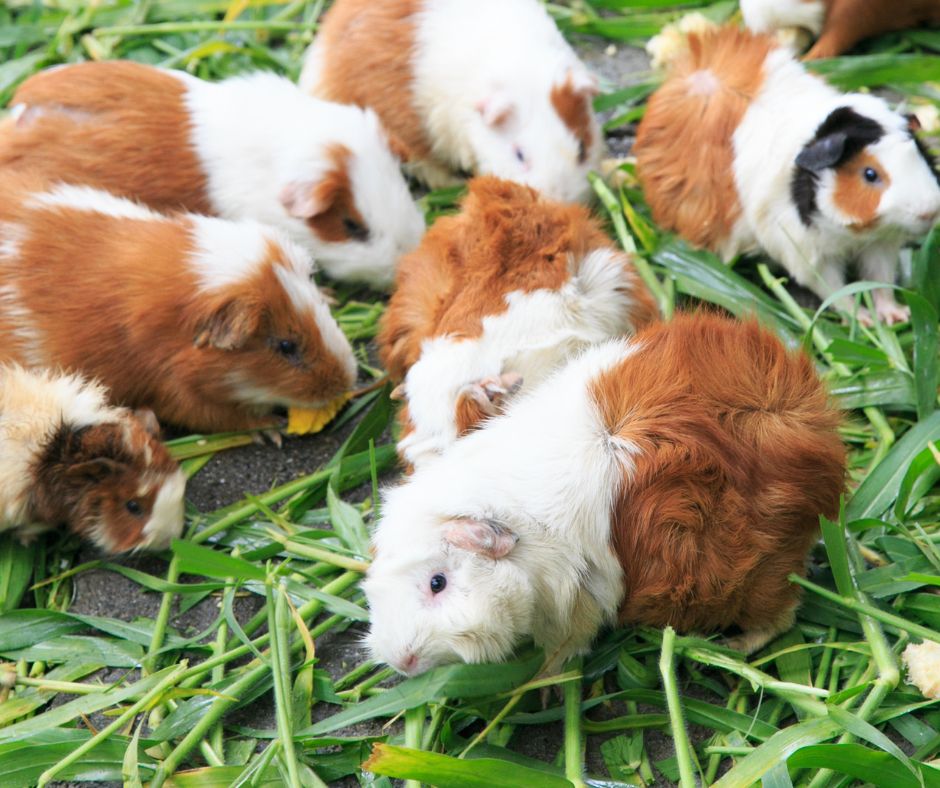
Deciding what to feed your guinea pig is one of the most important parts of being a cavy owner. Luckily, you’ll have many inexpensive options to keep your piggie fed and happy.
Cavies are natural herbivores, and in the wild, will eat anything from fruits and leaves to root vegetables and high-fiber grasses. In captivity, you’ll be able to satisfy their appetite with:
Store-bought pellet food: Commercial guinea pig foods are formulated with Vitamin C and other essential nutrients to provide balanced nutrition.
Hay: This is a staple in a guinea pig’s diet and provides necessary fibers to prevent digestive problems.
Good-quality hay is usually green in color and sweet in smell, but avoid grasses like legume or alfalfa hay. Instead, opt for grasses like Timothy Hay, Orchard Hay, and Meadow Hay.
Fresh Vegetables: Fresh, organic greens are a great addition to your guinea pig’s diet. Since their bodies are unable to make their own Vitamin C, vegetables work as excellent supplements and should be fed to your piggies daily.
Feed up to one cup of the following vegetables per day:
- Carrots
- Romaine lettuce (never iceberg)
- Spinach
- Peas
- Brocolli
- Kale
- Green and red bell peppers
- Tomatoes (no leaves or stem)
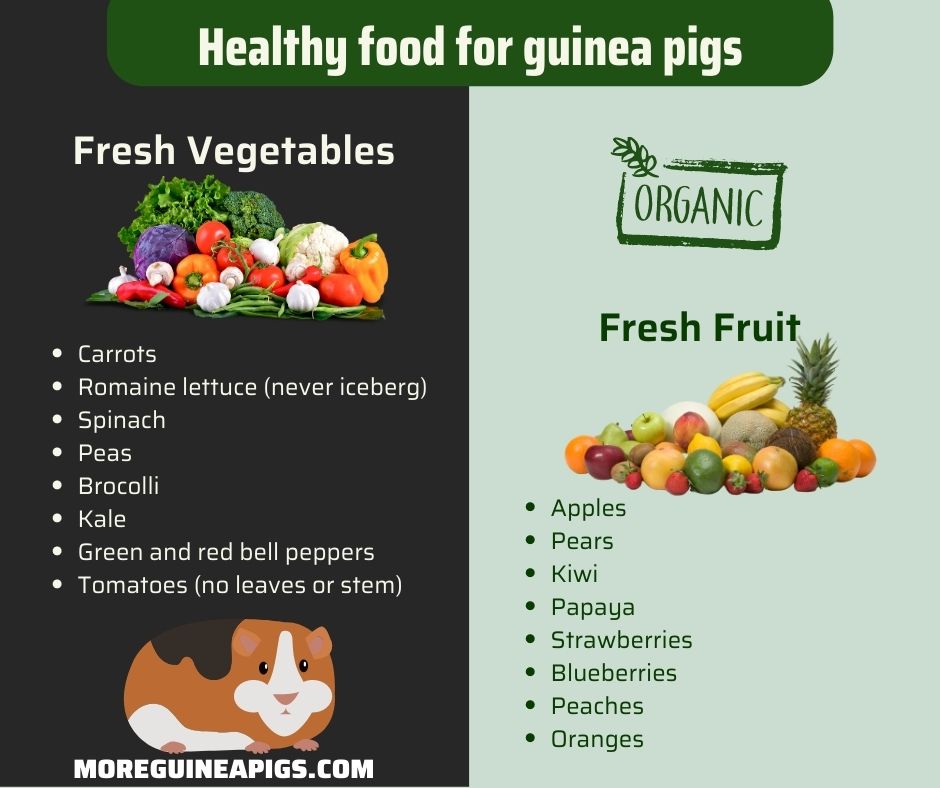
Fresh Fruit: In moderation, fruits are a delightful treat for guinea pigs and provide a healthy amount of Vitamin C. Here are common fruits that are safe for piggies:
- Apples
- Pears
- Kiwi
- Papaya
- Strawberries
- Blueberries
- Peaches
- Oranges
Guinea pigs have a sensitive digestive system, and certain foods that are too high in fat or sugar can cause your piggies to become very sick. These are the foods that you should avoid feeding your guinea pigs:
- Onions
- Garlic
- Mushrooms
- Bread
- Meat
- Potatoes
- Nuts
- Corn Kernels
- Avocados
- Rhubarb
- Cabbage
- Dairy Products
- Chocolate
Read more:
3/ Guinea Pig Ate Poisonous Plant: Symptoms and Treatment
Conclusion
Guinea pigs are wonderful companions for both children and adults. They’re relatively easy to maintain, a joy to watch and interact with, and provide companionship as unique as their quirky personalities.
Once you’re prepared to adopt a guinea pig, purchase everything you’ll need, and provide quality care for your new pet, you can look forward to many years of love and fun with your precious piggies.
